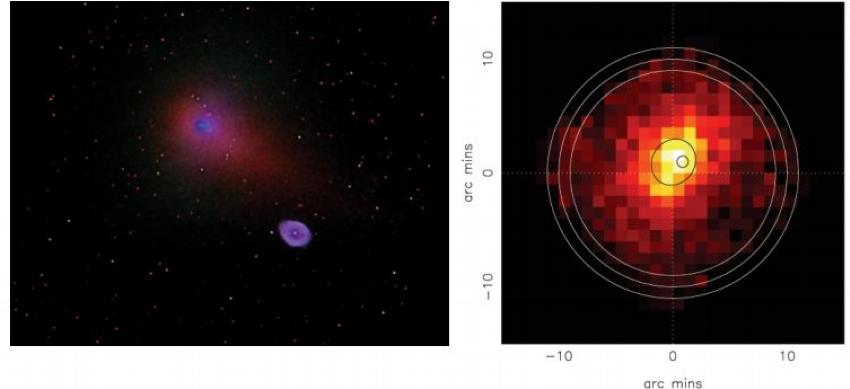
 Credit: UV: NASA/Swift/UVOT/PSU/Peter Brown; X-ray: NASA/Swift/XRT/U. Leicester/Richard Willingale
Credit: UV: NASA/Swift/UVOT/PSU/Peter Brown; X-ray: NASA/Swift/XRT/U. Leicester/Richard Willingale
A Swift Comet
X-ray and UV instruments are usually used to study very hot objects, like titanic explosions. But snowballs? Cosmic snowballs, or comets, actually show interesting behaviors which can best be studied by high energy X-ray and UV instruments. The images above were obtained by the Swift satellite, which is usually used to study gamma-ray bursts. But the UV and Optical telescope on Swift, or UVOT, took the beautiful picture shown above left of Comet 73P/Schwassmann-Wachmann 3 as it nearly transits the Ring Nebula. The comet is the nebulous object near the center of the image, while the Ring Nebula is the circular object just below it to the right. The image on the right is an image of the comet obtained by the Swift X-ray telescope. It turns out that Comet 73P/Schwassmann-Wachmann 3 is the brightest comet ever observed at X-ray energies.
<
HEA Dictionary ● Archive
● Search HEAPOW
● Other Languages
● HEAPOW on Facebook
● Download all Images
● Education ● HEAD
>
Each week the HEASARC
brings you new, exciting and beautiful images from X-ray and Gamma ray
astronomy. Check back each week and be sure to check out the HEAPOW archive!
Page Author: Dr. Michael F. Corcoran
Last modified Tuesday, 27-Feb-2024 10:08:17 EST


